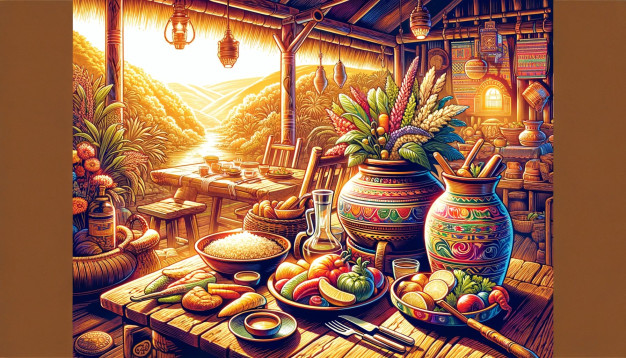Gastronomy of Bolivia
Explore Bolivia's rich culinary heritage, from salteñas to quinoa dishes.

Diversity and Influence
Bolivian cuisine is a kaleidoscope of flavors, reflecting the country’s rich cultural diversity. The gastronomy is a savory tapestry woven with indigenous, Spanish, African, and even Asian influences. From the high Andean plateaus to the lush Amazon basin, the variety is astounding.
Altitude and Agriculture
At sky-high altitudes, Bolivians cultivate an array of tubers and grains like nowhere else on Earth. Quinoa and Bolivia are practically BFFs, and let’s not even get started on the 200+ varieties of potatoes. High-altitude cooking? It’s not just a fad here; it’s a way of life.
Traditional Bolivian Dishes
Salteñas
Salteñas are the morning glory of Bolivian street food. Think of them as empanadas with a PhD in deliciousness—stuffed with a juicy mix of meat, veggies, and a secret sauce that’s guarded more fiercely than national treasures.
Silpancho
Silpancho is a dish not for the faint-hearted—or those with tiny appetites. A bed of rice and potatoes gets crowned with a thin, breaded beef cutlet, topped with fried eggs, and garnished with pico de gallo. It’s the edible equivalent of a warm hug.
Anticuchos
Anticuchos can be a bit of a surprise for the uninitiated. Skewered and grilled beef hearts that are so tender and flavorful, they might just convert the skeptical into organ meat aficionados.
Pique a lo Macho
Pique a lo Macho is a heaping plate of meat, sausage, onions, locoto (hot pepper), and boiled eggs. It’s the Bolivian answer to the question, “Can this dish get any more macho?” Yes, yes it can—with more hot sauce!
Bolivian Street Food
Tucumanas
Tucumanas are like the rebel cousins of Salteñas—fried until golden and perfect for those who believe that life’s too short not to deep-fry your snacks.
Choripan
Choripan is the ultimate street snack: a juicy chorizo nestled in fresh bread, begging to be slathered with llajwa, Bolivia’s beloved spicy sauce. It’s the South American hot dog, but with a degree in culinary arts.
Humintas
Bolivian humintas are the original tamales’ cooler older brother. Corn dough wrapped in cornhusk—or banana leaves if they’re feeling tropical—and then steamed or baked. It’s a corny love affair in every bite.
Bolivian Soups and Stews
Sopa de Mani
Sopa de Mani is a peanut soup that manages to be both hearty and elegant. It’s the Audrey Hepburn of soups, if Audrey Hepburn were Bolivian and deliciously edible.
Chairo
Chairo is an Andean stew that’s as rustic and comforting as a woolen poncho. It’s packed with potatoes, oxtail, and chuño (freeze-dried potatoes) because in Bolivia, you can never have too many potatoes.
Fricase
Fricase is not a misspelled French dish but a spicy pork stew that warms you faster than an alpaca sweater. It’s like the stew equivalent of having a lively salsa dance inside your mouth.
Bolivian Desserts
Cuñapé
Cuñapé is a cheesy bread that’s gluten-free and addictive. It’s the kind of snack that whispers sweet nothings to your taste buds and makes them swoon.
Helado de Canela
Helado de Canela is cinnamon ice cream that’s as refreshing as a high-altitude breeze. Forget vanilla; this is the ice cream flavor that’ll make you question all your life choices leading up to this moment.
Tawa-Tawas
Tawa-Tawas are fried pastries that puff up like the egos at a gourmet chefs’ convention. Dusted with powdered sugar, they’re the ultimate sweet treat to reward yourself after a day of high-altitude exploring.
Popular Bolivian Beverages
Chicha
Chicha is an ancient corn beer that’s both a drink and a cultural experience. It’s like sipping on liquid history—fermented, of course.
Singani
Singani is the national spirit, distilled from white Muscat grapes. It’s so smooth, it’ll make you recite poetry, or at least think you can.
Yungueño
The Yungueño is a cocktail that’s as colorful and vibrant as the Bolivian jungles. Singani, orange juice, and a splash of grenadine—it’s basically a tropical vacation in a glass.
Regional Variations in Bolivian Gastronomy
Andean Region Delicacies
The Andean region dishes out quinoa and potato masterpieces, while charquekan, dried llama meat, proves that jerky’s got nothing on Bolivia’s preservation game.
Amazon Basin Flavors
In the Amazon Basin, the flavors dive into the wild with dishes like majadito (rice mixed with dried meat) and masaco (plantain or yuca mashed with chicharrón), showcasing the jungle’s bounty.
Food of the Gran Chaco
The Gran Chaco region brings to the table gamey goodness in the form of tatú al horno—baked armadillo, a dish for the adventurous eater who’s done playing it safe.
Bolivian Food Festivals and Events
Gran Poder Festival
At the Gran Poder Festival, the feast is as vibrant as the costumes. It’s a foodie’s dream, with street vendors serving everything from anticuchos to choclo con queso (corn with cheese).
Alasitas Fair
The Alasitas Fair is where miniature food replicas steal the show. It’s a buffet for the eyes, and yes, that tiny empanada is too cute to eat, but find a real one and dig in!
Fiesta de la Virgen de Urkupiña
During the Fiesta de la Virgen de Urkupiña, the divine and the delicious intersect. Sample traditional dishes as you witness the faith and gastronomy of Bolivia intertwine.
Impact of Bolivian Cuisine Globally
Fusion and Adaptations
Bolivian dishes are the new kids on the global food scene—quinoa has become the hipster grain of choice, and Bolivian flavors are spicing up fusion restaurants worldwide.
Bolivian Restaurants Around the World
Bolivian restaurants outside the country might be rarer than a well-done steak at a vegan convention, but they’re out there, introducing salteñas and llajwa to an international clientele hungry for a taste of the Andes.
Bolivian gastronomy is a testament to the country’s diversity and history. From hearty stews to spicy street food, Bolivia serves up a menu as colorful and varied as its landscapes. It’s a culinary adventure that proves you don’t need to be a sizeable gastronomical giant to pack a flavor punch that resonates around the globe.